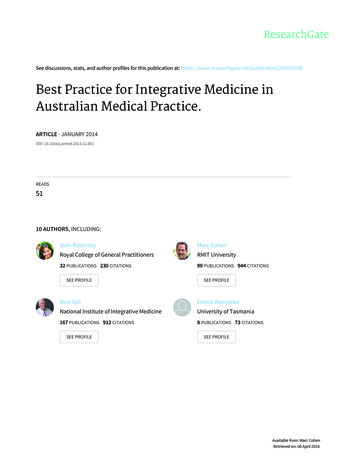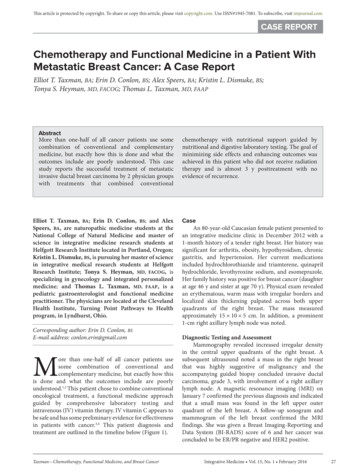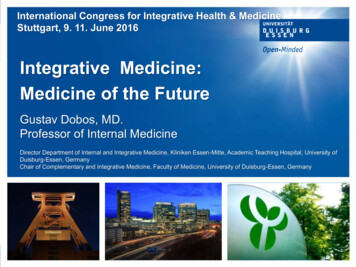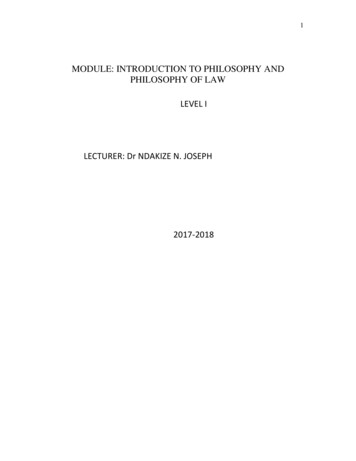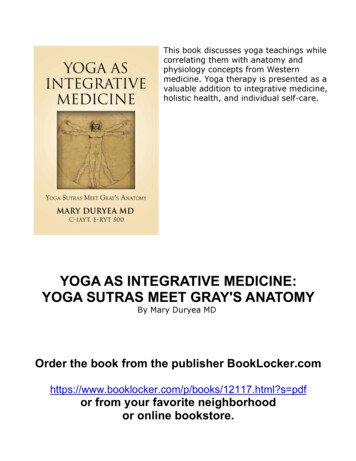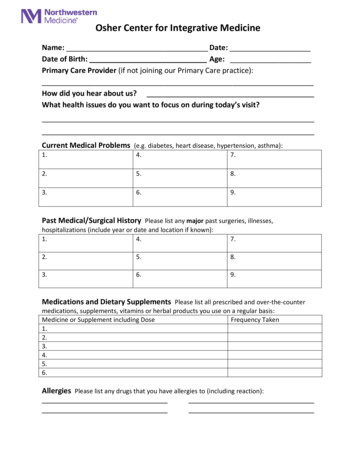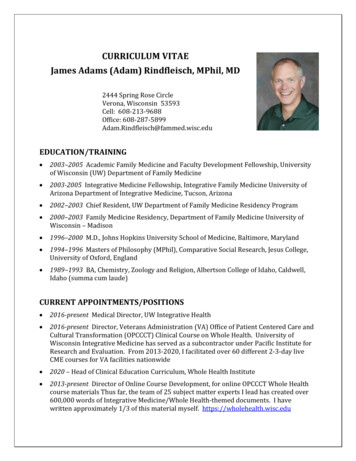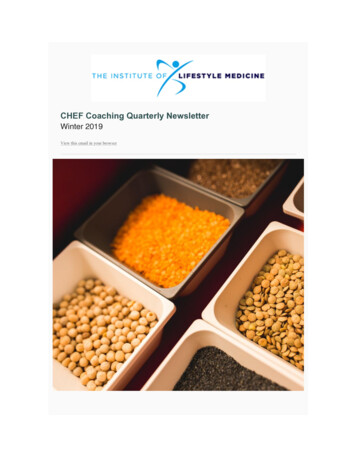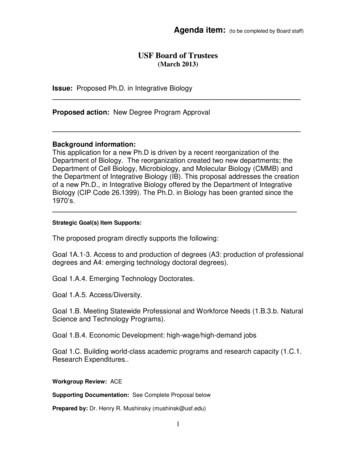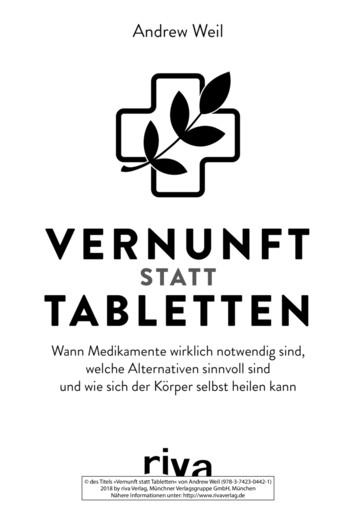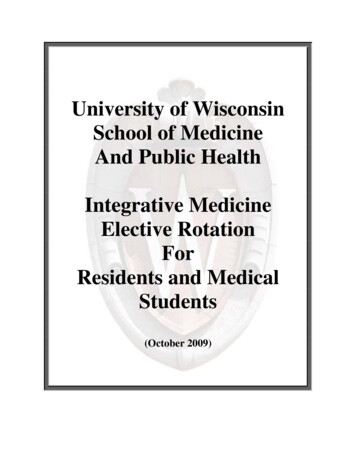
Transcription
University of WisconsinSchool of MedicineAnd Public HealthIntegrative MedicineElective RotationForResidents and MedicalStudents(October 2009)
April, 2009Dear Residents & Medical Students,Welcome to the elective rotation in Integrative Medicine! My colleagues and I are delightedthat you are joining us. We both expect and hope that the experiences and knowledge that yougain with us will augment your already strong medical education, and help you think in newways, enhancing your own health as well as the health of your future patients.In this packet you’ll find our Integrative Medicine curriculum, philosophy of IntegrativeMedicine, and contact lists of holistic health practitioners. Read, experience, learn! Feel free tocontact me with questions/comments/concerns. Others are here to help as well. See below.Physicians (MD’s)Luke Fortney, Asst. Prof.(cell) 576-0413Jill Mallory, IM Fellow274-1100luke.fortney@fammed.wisc.edue-mail preferredjill.mallory@fammed.wisc.eduLucille Marchand, Prof.(pager) 376-7819Clinical Director, Integrative Oncology Svcs.lucille.marchand@fammed.wisc.eduRian Podein, Asst. Prof.rian.podein@fammed.wisc.edu(pager) 376-9217Dave Rakel, Asst. Prof.,Director, Integrative Medicine265-8421drakel@uwhealth.orgAdam Rindfleisch, Asst. Prof.Director, Academic IntegrativeMedicine lene LuchterhandIM Program uJanet ShortDFM Medical Student e KlescewskiDFM Residency SchedulingSincerely,David Rakel, MD, Asst. Prof.Director, UW Integrative Medicine2
Integrative Medicine Learning ObjectivesWe have three overall learning objectives for this rotation. We would like you:1. To promote self-exploration/self-care.2. To develop an understanding of Integrative Medicine.3. To explore an area of interest within Integrative Medicine.BackgroundWhat is Integrative Medicine?The concept of integrative medicine arises from a need to appreciate the wholeness of anindividual person.This means learning to view a person from abiological/psychological/social/spiritual perspective. Moreover, integrative medicine ishealing oriented and emphasizes the centrality of the doctor-patient relationship. Itfocuses on the least invasive, least toxic, and least costly methods to help facilitate healthby integrating the best of both worlds—allopathic (conventional) and complementarytherapies. The founder of allopathic medicine, Sir William Osler, wrote, “It is muchmore important to know what sort of patient has a disease than what sort of disease apatient has.”What is Healing?Health comes from the Old English word “Hal,” meaning wholeness, soundness, orspiritual wellness. “Health” is defined by the World Health Organization as “a state ofcomplete physical, mental, and social well being, and not merely the absence of diseaseor infirmity.” To “cure,” conversely, refers to doing something (such as giving drugs orperforming surgery) that alleviates a troublesome condition or disease. Healing does notequal curing. Healing facilitates change that reduces stress, improves diet, promotesexercise, and increases the person’s sense of community and connection. In doing this,we help improve the balance of health of the body, mind, and spirit that may result in theability to discontinue a pharmaceutical, thereby reducing the need for the cure.The Integrative Physician:In order to be an effective practitioner of health and healing, one must understand healthat a personal level. This equates with personal introspection, exploration, and anexperience of well being and balance. Because integrative medicine looks deeply into thelife of an individual patient, it requires a deeper personal understanding on the part of thephysician. As a result, this type of practitioner is more successful with health and healingdue to the fact that s/he develops rapport, understanding, and empathy with patients. Thistype of relationship fosters healing by allowing the practitioner to gain personal, andempathetic insight into the patient’s unique situation. Likewise, the best way to practiceand learn integrative medicine is to explore one’s own personal definition of health, aswell as directly experience a number of different styles and modalities of healing.3
Integrative Medicine CurriculumWith the above mentioned concepts in mind, the integrative medicine learning experiencewill develop individually based on your own personal interests and moments of insight.1. Explore, meet, and experience! These are essential to fostering a sense ofpersonal health and healing that is imperative to providing good holistic medicalcare. In addition to extrinsic textbook learning, intrinsic learning can only beacquired through experience and self exploration. This type of knowledge iscommonly known as wisdom. Lao Tsu writes, “Knowledge studies others,Wisdom is self-known.” Likewise, Roger Walsh, MD Ph.D., writes that“Wisdom must be developed if we are to understand life and ourselves and tolive well.” Exploration of different healing modalities is only the beginning totruly understanding health and healing; but intrinsic to it is the exploration ofself that leads to wisdom that will reap great rewards in the practice of medicine.Pragmatically, this means calling various complementary medicine practitionersand arranging meetings and sessions to learn and directly experience what theydo. (You will find lists of both UW Health Integrative Medicine ancillary staffand community practitioners in this packet). Keep in mind that not all things canbe known or learned through reading or reasoning. Roger Walsh describes thistype of learning and knowing through analogy: “Compared to direct realization,mere book learning and theoretical knowledge are very poor substitutes, as farremoved from direct experience as a text on human reproduction is from theembrace of a lover.” Remember, this rotation is about exploring what it meansto be a human being, so that we can better understand health and treat disease.2. Write a personal definition of health and devise a treatment plan. Part of theintegrative experience includes a short write-up that carefully reflects your owndefinition of health. What does health mean to you personally and in your ownlife? This task can be challenging, similar to writing a personal statement. Itmeans being real and reflecting on your past and looking ahead to your futurewhile finding out what it means to be healthy in the present moment.Additionally, at the end of the rotation, you will put together a treatment plan foryourself, similar to the patient health treatment plans you put togetherthroughout this rotation. These tasks serve two purposes. First, defining healthputs you into a mindset that facilitates better interaction and understanding withthe various patients seeking improved health and resolution of disease. Second,writing your own treatment plan materializes your definition of health in a waythat gives direction, focus, and memory to your intention and goals for balance,well-being, health, and healing.See the following websites for tools to help with this process:4
*Required* American Medical Student Association’s Healing the Healer:Developing Your Own Health Planwww.amsa.org/healingthehealer/index.cfm?secure yes .The University of Minnesota’s Center for Spirituality and Healing: Has aninteractive web site for exploring your own health from an integrative medicineperspective. http://www.csh.umn.edu/modpub/ .University of Wisconsin Integrative Medicine Intake Evaluation FormFind at http://www.uwhealth.org/storage/IM ClientInformationForm.pdf.3.Integrative Medicine Clinic. Your role is to observe, emulate, and participate invarying capacities. Initially, new patients will be seen by you and the integrativemedicine physician or fellow. This initial interview is meant to develop anunderstanding of the uniqueness of the patient and acquire a better insight of thatpatient’s needs. Be an active participant in the interview process. Afterwards,you and the physician will discuss each patient and devise an in-depth treatmentplan that addresses the uniqueness of the individual. Remember, integrativemedicine attempts to bring a wealth of resources to meet an individual’s uniqueneeds, as opposed to a method of bringing the same biomedical model to everypatient. Simply, this means developing a treatment plan that is specificallytailored to individual patients in a way that will best meet their needs in aholistic fashion. Your job in this process will include selecting a patient fromclinic and working up a treatment plan for her/him using the wealth of resourcesavailable to you from the Integrative Medicine Clinic, in addition to your ownreading and literature searches.4. Read the following: (Included at end of this package). The following willprovide an overview of integrative medicine. Rakel DP, Weil A. The Philosophy of Integrative Medicine. In Rakel DP(Ed) Integrative Medicine, 2nd edition, Saunders, an imprint of Elsevier,2007. (At end of document) Reilly, D. Enhancing human healing. BMJ 2001;322:120-121. Snyderman, R & Weil, A. Integrative medicine: bringing medicine backto its roots. Arch Intern Med 2002 Feb 25;162(4):395-7.5. Independent reading. Because this rotation is flexible and adapts to your ownpersonal interests, additional readings will be based on your experiences andquestions. It is always best to read about those things that you experience tohelp facilitate lasting memory and working knowledge. Of course, in manysituations, it may be best to experience a particular modality of medicine (e.g.energy medicine such as healing touch) before reading about it. This way, youwill be more receptive, open, and sensitive to the experience before altering yourperception of it through reading. Take advantage of your “beginners mind,” anopen vessel ready to be filled.5
The following websites can be of help for resources on CAM: American Medical Student .cfm National Center for Complementary and Alternative Medicine (NIH):http://nccam.nih.gov/6. Choose one or two areas of interest in which to focus during this rotation. Thefield of complementary and alternative medicine is expansive and daunting.However, the principles of healing apply to all modalities within the field.Specifically, you will learn through experiencing various modalities that healingfollows a common pattern. First, there is a health related crisis (e.g. severe,refractory eczema). Second, there is a search for and arrival at a place of healing(e.g. a medical clinic). Third, there is an explanation of the situation followed bydevelopment of a treatment plan (e.g. hydrocortisone cream and quittingsmoking). Finally, there is resolution (or re-evaluation) followed by memory,reflection, and attainment of experiential understanding on the part of the patient(e.g. certain behaviors/memories/emotions make my eczema worse and certaininterventions make my eczema better). However, in order to really appreciatethe wisdom and knowledge of a particular healing modality in so short a timeframe as a two-four week rotation, it is best to focus on one or two areas ofinterest (e.g. energy medicine, homeopathy, botanical/herbal medicine,Traditional Chinese Medicine, manual medicine, meditation/spirituality, etc).Remember that lasting memory comes from understanding at greater depth andlevel of experience. Discuss your area/s of interest with one of the Integrative Medicine ProgramFaculty or Fellows: Luke Fortney, Lucille Marchand, Rian Podein, DavidRakel, Adam Rindfleisch Share what you have learned by contributing to our Integrative MedicineProgram data files. This involves creating a handout (1-2 pages) in laylanguage that helps individuals understand how this therapy will enhance theirhealth. Write the handout, so it is self-explanatory for patients. (For anexample, see “Using Journaling to Aid Health” on the following page).7. Finally, relax. Get to know yourself. We recommend that you smile, explore,open-up, and most importantly let go. This is fun. Medicine is fun. Life is fun.Be open to the possibilities of health and healing while simultaneouslymaintaining an appropriate and healthy skepticism. Life’s Little InstructionBook has a quote that expresses this well, “Don’t be so open-minded that all ofyour brains fall out.” But at the same time, maintain a sense of openness. Thebeginner’s mind is a powerful way to learn and experience this type of medicine.The above was written by Luke Fortney, MS IV, UWMS, in association with Dave RakelMD, 2002. Revised: 2006 with help of Surya Pierce, MS IV.6
7
8
OPPORTUNITIES FOR EXPERIENTIAL LEARNINGThere are two options for experiential learning about a specific modality: 1) You can contact amember of the UW Integrative Medicine Ancillary Staff and arrange to observe/shadow,experience the treatment yourself, or discuss the modality. Please let the contact person knowthat you are doing an elective rotation with Integrative Medicine. Go to the followingwebsite for more information about modalities: www.uwhealth.org/integrativemed. 2) You cancontact a practitioner in the community. See page 11.UW INTEGRATIVE MEDICINE ANCILLARY STAFFFollowing are scheduled times for various modalities. Please note that schedules can changeand shadowing is subject to patient consent.AcupunctureTues. 9am-1pm. Practitioner: Dan Cubacub. Research Park Clinic.Wed. 9am-4pm. Practitioner: Dan Cubacub. Research Park Clinic.Thur. 9am-4pm. Practitioner: Mihal Davis. UW Comp. Cancer Center.Thur. 9am-4pm. Practitioner: Colleen Lewis. Odana Atrium Clinic.Fri. 12:30 pm-8pm. Practitioner: Colleen Lewis. Research Park Clinic.Sat. 9am-3pm. Practitioner: Colleen Lewis. Research Park Clinic.Feldenkrais MethodWed. 1pm-4:30pm. Practitioner: Hagit Vardi. Research Park Clinic.Thur. 9am-12:30pm. Practitioner: Hagit Vardi. Research Park Clinic.Hagit prefers to schedule a treatment session for those interested in her work.Healing TouchNot open to observation. Educational sessions are available with the HealingTouch Practitioners. Contact Mike Johnson (below) to learn more.Massage Therapy/BodyworkGenerally massage therapy/bodywork sessions are not observed. Educationalmeetings can be arranged. Contact Mike Johnson, who coordinates the program,to learn more.To shadow/observe or schedule an appointment to discuss and learn more aboutacupuncture, Feldenkrais, Healing Touch, or massage therapy /bodywork: contactMike Johnson at 265-8349 or MJohnson6@uwhealth.org.Eastern PracticesIncludes classes such as Ai Chi, Yoga, Feldenkrais ATM, T’ai Chi, and Qigong.To learn more or sit in on a class, contact Lisa Milbrandt at 265-8317 orLMilbrandt@uwhealth.org.9
Exercise PhysiologyTo learn about the application of the principles of exercise physiology to a widevariety of people (i.e., clinically ill to athletic), contact Jude Sullivan at 265-8324or JSullivan@uwhealth.org. He may arrange an appointment or suggest anotherof his colleagues to contact.Health PsychologySessions with patients are not open to observation. Health psychologists offer anhour-long meeting to discuss their work and demonstrate biofeedback. ContactShilagh Mirgain at SMirgain@uwhealth.org or Janice Singles atJSingles@uwhealth.org to schedule an appointment.MindfulnessIf you are interested in learning more about the Mindfulness Program or inexperiencing an individual session as a patient would do, contact KatherineBonus at 265-8417 or KBonus@uwhealth.org. She may arrange an appointmentor suggest another of her colleagues to contact.10
University of Wisconsin Integrative Medicine ProgramCommunity Holistic Practitioners Who Provide Information/Shadowing Opportunitiesfor Medical Students and ResidentsPlease call individual practitioners to learn more about a modality and to schedule a visit.NameAcupunctureFran Ehrlich, MDPhone256-8879 (H)Ronghua Jiang, M.D.(China)Xiping Zhou, M.D.O.M.L.Ac.Chiropractic CareKelly Andrews, D.C.288-1240E-mail & WebsiteAddressNotesNo409 E. Washington Ave.No715 Hill St., Suite 230Auricular acupunctureEnergy MedicineChinese Medicine236-9000www.herbalpalace.com6425 Normandy LaneProfessor of ChineseMedicine577-5230 (cell)chirokelly@tds.netGroup Health Sauk TrailsClinic 8202 ExcelsiorDrivePrevious modalities usedinclude NAET &nutritional detox. Willexplain these, but doesn’tuse in current setting.409 E. Washington Ave.Auricular acupunctureEnergy Medicine715 Hill St., Suite 200Certified AGIAlso does psychotherapyand mindfulness.Classical homeopath witha background in familymedicineCall if serious about theprocess as a modality.Energy Work256-8879 (H)Fran Ehrlich, MDNoGuided ImageryMare Chapman, M.A.233-7431Ext. athyPaul Branch, MD273-3619pbranch@mindspring.com2122 Luann LaneDavid Johnson260-8000406 N. PinckneyKaren Kunkler renkunkler@gmail.com3310 University Ave.Suite 204N.D who is boardcertified in homeopathyNaturopathyMihal Davis, ND, CA588-4464mihaldavis@hotmail.comGrandmother MoonClinic, LLC608 Water St., Apt. APrairie du Sac, WIKaren Kunkler N.D.232-0262Jill Evenson N.D. &colleagues, NaturopathicFamily thicfamilyclinic.com3310 University Ave.Suite 2044539 Woodgate Dr.,Suite AJanesville, WI 53546Board-certifiedNaturopathic physician.Also a certifiedacupuncturist specializingin acupuncture, nutritionand western herbs.N.D. who is boardcertified in homeopathyBoard-certified N.D.Continued on next page.11
PharmacyCommunity munitypharmacy.coop341 State St.Contact: Any member ofthe outreach team.Herbs, homeopathics,supplements, vitaminsGreen Earth831-2845herbman50@tds.net6771 University Ave.,Middleton 53562Quintessence251-6915Contact:David La LuzerneHerbs, homeopathics,vitamins. (Noprescriptions or OTCs)Closed Th, Sun.Contact: RichardLevinsonHerbals & homeopathics.Will meet to talk aboutbotanicals.ReikiChristine .healingandbalance.comTravels between 3locations, including GHC& Meriter WellnessCenter. Discuss where tomeet.Reiki Master Teacher,Clinical Hypnotherapist,Meditation, Tai Chi,Qigong, IntegrativeCounseling & lth.org600 Highland Ave.Spiritual Care Svcs., UWHosp. & ClinicsSpiritual Care Svcs., UWHosp. & ClinicsSpiritualityPenny Andrews, D.MinSteve Wenk, M.Div.,BCCYogaJonathan Garber, RMT265-0255246-8515Jerry Landau, M.Ac.236-9138Maruti Landau236-9138334 W. Lakeside St.600 Highland .comjlandau@chorus.netwww.wellwithinmadison.com301 S. Bedford St.Mail: P.O. Box 258001,Madison, WI 53725www.wellwithinmadison.com715 Hill St., Suite 130715 Hill St., Suite 130Yoga therapy for childrenwith disabilities.Massage/lymphatictherapy for adults.Acupuncture. Nutritionfrom a Chinese Medicine& Ayurvedic approach.Yoga Therapy.Support for women inmid-life. Yoga forskeletal health (preventingosteoporosis).12
Philosophy of Integrative MedicineDavid Rakel MDAsst. Prof. Dept. of Family MedicineUniversity of Wisconsin Medical SchoolMadison, WI.drakel@fammed.wisc.eduAndrew Weil MDDirector, Program in Integrative MedicineClinical Professor of MedicineUniversity of Arizona Health Sciences CenterTucson, AZ.6700 S. X9 Ranch RdVail, AZ 85641Published:Rakel DP, Weil A. Philosophy of Integrative Medicine. In: Rakel DP (Ed) IntegrativeMedicine, 2nd Ed. WB Saunders. Philadelphia, PA. 2007 (In Print)A Brief History of Integrative MedicineFrom Aristotle to the Flexner reportWhen religion was strong and medicine weak, men mistook magic for medicine;Now, when science is strong and religion weak, men mistake medicine for magic.Thomas Szasz, The Second SinThe philosophy of integrative medicine is not new. It has been talked about for agesacross many disciplines. It has simply been overlooked as the pendulum of acceptedmedical care swings from one extreme to the other. We are currently experiencing thebeginning of a shift toward recognizing the benefits of combining the external, physicaland technological successes of curing with the internal, non-physical exploration ofhealing.Long before there were MRI and CT scanners, Aristotle (384-322 BC) was able to simplyexperience, observe and reflect on the human condition. He was one of the first holisticphysicians who believed that every person was a combination of both physical andspiritual properties with no separation between mind and body. It was not until the 1600’s13
that a spiritual mathematician became worried that prevailing scientific materialisticthought would reduce the conscious mind to something that could be manipulated andcontrolled. René Descartes (1596-1650), respecting the great unknown, did his best toseparate the mind and the body in order to protect the spirit from science. He believedthat mind and spirit should be the focus of the church leaving science to dissect thephysical body. This philosophy led to the “Cartesian split” of mind/body duality.Shortly after, John Locke (1632-1704) and David Hume (1711-1776) influenced thereductionistic movement that shaped our science and medical system. The idea was that ifwe could reduce natural phenomena to greater simplicity, we could understand the largerwhole. So to learn about a clock, all we need to do is study its parts. Reductionismfacilitated great discoveries that helped humans gain control over their environment.Despite this progress, physicians had few tools to treat disease effectively. In the early20th century, applied science started to transform medicine. In 1910, the Flexner report 1was written and had a significant impact on the development of allopathic academicinstitutions. They came to emphasize the triad that prevails today, research, education andclinical practice. Reductionism and the scientific method produced the knowledge thatencouraged the growth of these institutions.The scientific model led to greater understanding of the pathophysiological basis ofdisease and the development of tools to help combat its influence. Sub-specialization ofmedical care facilitated the application of all the new information. We now havepractitioners who focus on the pieces and a society that appreciates their abilities to fixproblems. Unfortunately this approach does not work well for chronic disease thatinvolves more than just a single part. In fact, all body organs are interconnected so thatonly repairing a part without addressing the underlying causes for its failure providesonly temporary relief and a false sense of security.More technology, less communication.The tremendous success of medical science of the 20th century was not without cost. Theamount of money allocated to health over the past 10 years has almost doubled from 391to 668 billion dollars. The health care market grows when more attention is focused onparts that can be treated with drugs or procedures. In 2003, drug spending in the U.S. rose11% to 180 billion and is now 15% higher than any other health related expenditure. 2Financial rewards increase when there are more subtypes of disease that treatments canbe matched to. The system encourages patients to believe that tools are the answer totheir physical woes and discourages them from paying attention to the interplay of mind,community, and spirit. Technology is the golden calf in this scenario. We have becomedependent on it and over utilization has widened the barrier of communication betweenpatient and provider. The old tools of the trade --rapport, gestalt, intuition and laying onof hands -- were used less and less as powerful drugs and high-tech interventions becameavailable.1Flexner, A. Medical Education in the United States and Canada: A Report to the Carnegie Foundation forthe Advancement of Teaching. New York, NY: Carnegie, 1910.2National Center for Health Statistics. Trends in the Health of Americans. Hyattsville, Maryland. 2004.14
To help curtail costs, managed care and capitation were born. These new models reducedexcessive costs and further eroded the patient-provider relationship; placing increaseddemands on physicians that did not involve patient care. Physician and patient unrestfollowed. Doctors are unhappy in part because of loss of autonomy in practicingmedicine. Patients are unhappy in part because they feel they are not getting the attentionthey need. Most upset are those with chronic medical conditions whose diseases do notrespond well to the treatments of specialized medicine. This comes at a time when theincidence of chronic and degenerative diseases is at an all-time high. Diseases like heartdisease, diabetes, irritable bowel syndrome, chronic fatigue and chronic pain syndromesare very common. They require evaluation and treatment of much more than any oneorgan. The public has started to realize the limitations of western medicine and wantsmore attention paid to health and healing of the whole person, especially when there is no“part” to be fixed.Public interest influences changeThe deterioration of the patient-provider relationship, the over-utilization of technologyand the inability of the medical system to adequately treat chronic disease has contributedto rising interest in complementary and alternative medicine (CAM). The public has sentits message with feet and pocket books. In fact there were more visits to CAM providersin the early 1990s than to all primary care medical physicians, and patients paid for thesevisits out of pocket with an estimated expenditure of 13 billion. 3 This trend continuedthroughout the 90’s with 42% of the public using alternative therapies, increasingexpenditures to 27 billion from 1990-1997. 4 Patients are also demanding less aggressiveforms of therapy, and they are especially leery of the toxicity of pharmaceutical drugs.Adverse drug reactions have become the 6th leading cause of death 5 in hospitalizedpatients, and in 1994, botanicals were the largest growth area in retail pharmacy. 6Research shows that people find complementary approaches to be more aligned with“their own values, beliefs, and philosophical orientations toward health and life.” 7 Thepublic, before the medical establishment, realized that health and healing involved morethan pills and surgery. Less invasive, more traditional treatments such as nutrition,botanicals, manipulation, meditation, massage and others that were neglected during theexplosion of medical science and technology were now being rediscovered with greatenthusiasm.Medicine gets the messageThe popularity of CAM therapies created a need for research in these areas. In 1993 anoffice of alternative medicine (OAM) was started within the National Institutes of Health3Eisenberg DM, Kessler RC, Foster C, et al. Unconventional medicine in the United States-prevalence,costs and patterns of use. N Eng J Med 1993;328:246-52.4Eisenberg D, Davis RB, Ettner SL, et al. Trends in alternative medicine use in the United States, 19901997: results of a follow-up national survey. JAMA 1998; 280:1569-1575.5Lazarou J, Pomeranz BH, Corey PN. Incidence of adverse drug reactions in hospitalized patients. JAMA1998;279(15): 1200-1205.6Brevoort P. The United States botanical market-an overview. Herbal Gram 1996;36:49-57.7Astin JA. Why patients use alternative medicine: results of a national study. JAMA 1998;279:1548-53.15
(NIH). The initial budget was 2 million dollars, a fraction of the 80 billion dollar budgetof the NIH. The office was later upgraded to the National Center for Complementary andAlternative Medicine (NCCAM) and the amount of money available for scholarlyresearch kept pace with this growth. By the year 2006, the NCCAM budget grew to 122million. 8 This allowed for needed research for exploration of how these areas ofmedicine could enhance health care delivery. At first, researchers tried to use traditionalmethods to learn about CAM therapies. They were sufficient for studying some such asbotanicals. But the limitations of the reductionistic model became apparent when it wasapplied to more dynamic systems of healing like homeopathy, traditional Chinesemedicine and energy medicine. New methods were required to understand the multipleinfluences involved. Outcome studies with attention to quality of life were initiated.Research grants in “Frontier Medicine” were created to help learn about fields such asenergy medicine, homeopathy, magnet therapy and therapeutic prayer. Interest grew inlearning how to combine the successes of the scientific model with the potential of CAMto improve the delivery of health care.Academic Centers RespondIn 1997, one of the authors (AW) started the first fellowship program in IntegrativeMedicine at the University of Arizona. This two year clinical and research fellowship wascreated to train physicians about the science of health and healing and to learn moreabout therapies that were not part of the Western medical practice. There have been otherfellowship programs created since this time as well as a pilot project to incorporateintegrative medicine into a four-year family medicine residency-training model. NIHsponsored R-25 grants have been awarded to medical schools across the country to bringthese concepts into medical school curriculums. The Consortium of Academic HealthCenters for Integrative Medicine now comprises more than thirty medical schools fromacross the U.S. and Canada, bringing academic leaders together to transform healthcarethrough rigorous scientific studies, new models of clinical care, and innovativeeducational programs that integrate biomedicine, the complexity of human beings, theintrinsic nature of healing and the rich diversity of therapeutic systems. 9Complementary and Alternative Medicine Use G
The Philosophy of Integrative Medicine. In Rakel DP (Ed) Integrative Medicine, 2nd editionSaunders, an imprint of Elsevier, , 2007. (At end of document) Reilly, D. Enhancing human healing. BMJ 2001;322:120-121. Snyderman, R & Weil, A. Integrative medicine: bringing medicine back to its roots. Arch Intern Med 2002 Feb 25;162(4):395-7. 5.
